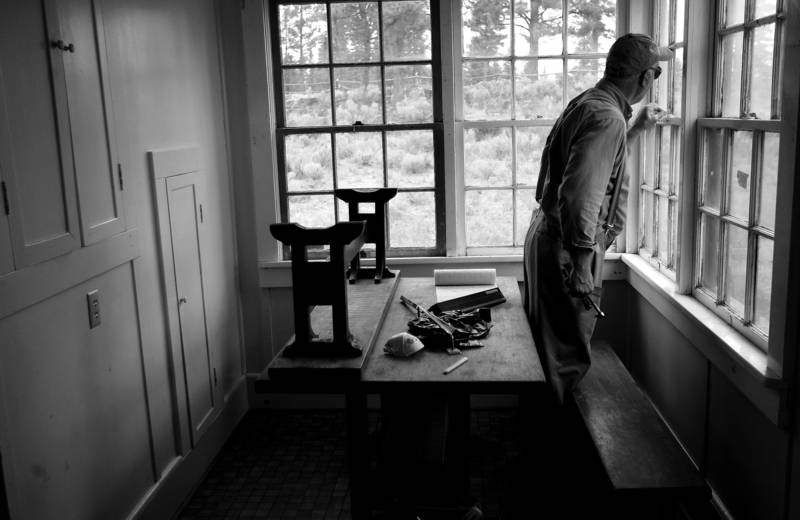Fort Rock ranger station reborn
Published 5:00 am Thursday, June 8, 2006

- Gordon Pfister looks over a screwed-together window pane in a kitchen nook in one of more than five buildings that make up the old Fort Rock Ranger District headquarters, southeast of La Pine. Behind Pfister sits a table and benches made by members of the Civilian Conservation Corps in the 1930s.
FORT ROCK – Don Franks fought fires from the Cabin Lake guard station, at the edge of the Deschutes National Forest, starting in the late 1940s. Now retired from the U.S. Forest Service, he often comes to the station to keep an eye on the ”guzzlers,” contraptions that collect and store water, which attract both birds and birders.
But this week, Franks is at Cabin Lake painting, scraping and digging holes to try and find a septic tank.
He’s one of the volunteers who, under the leadership of Forest Service archaeologists, are restoring and sprucing up the old ranger residence at the station for the public to rent. Franks, who lives a few miles south in Fort Rock and whose grandmother homesteaded in the area in 1907, said he hopes the restoration will allow birders, wildlife enthusiasts and school groups to enjoy the site in the future.
”A facility like this, if it’s just let gone, it’s such a waste. There’s so many people that like to come here,” Franks said.
”It’s here and all we have to do is surface maintain it, we’re not starting from scratch. And it’s such a setting.”
Situated where a pine forest thins out into the Fort Rock basin, about 30 miles east of La Pine, Cabin Lake was the headquarters for the Fort Rock Ranger District from 1921 to 1945. Early homesteaders in Lake County raised stock, and the Forest Service’s early role in the area included administering range allotments and managing the watershed, said Paul Claeyssens, heritage program manager for the Deschutes and Ochoco national forests.
”Some homesteads survived and many failed,” Claeyssens said. ”The population declined by the 1920s and into the ’30s. But the Forest Service maintained their presence here.”
In the 1930s, the Civilian Conservation Corps built the ranger’s residence and a complex of other buildings. The station employed lots of heavy wire and crank phones to communicate with lookouts at fire towers, Claeyssens said. Once a lookout spotted a fire, the goal was to put it out by 10 a.m. the next day before the wind and the heat picked up.
When the district headquarters moved to Bend in 1945, the ranger station became a guard station, hosting seasonal fire crews until 2002.
The Forest Service is now looking for new uses for some of its old buildings, Claeyssens said.
”We can’t maintain all our buildings, we don’t need all our buildings, but we want to keep some that are good examples of the Forest Service, historical architecture and settings,” he said. ”These are national forest system lands that are our legacy.”
Last summer, volunteers helped restore Fall River Guard Station cabins, which will be available to rent. This week, a total of about two dozen volunteers and nearby residents scraped old paint, applied multiple coats of new paint, repaired window screens and did other restoration work to get the ranger’s residence in shape for future rentals. Claeyssens said organizers hope to have both the Fall River cabins and the ranger’s residence available by the summer of 2007.
”We have just a huge amount of support from the public and from the Forest Service to do the work, so that’s very heartening,” said Janine McFarland, district archaeologist for the Bend-Fort Rock Ranger District and project leader for Cabin Lake.
Local support for the project is strong, said volunteer Donn O’Brien. She noted that of the 28 full-time residents of Fort Rock, 12 had registered to help out, including herself. Others had come as part of the Forest Service’s nationwide Passport in Time volunteer program.
For Gordon and Bunny Pfister of Renton, Wash., this was their 76th Passport in Time project.
”We’ve just had a good series of good experiences,” Gordon Pfister said. He added that the projects are opportunities to go new places, learn new things and meet new people.
This is the first phase of the project, McFarland said. She added that she hopes to attract more volunteers, partners and donations for future phases, which include restoring the other buildings and replacing some of the shingle roofs.
”It’s just a really neat opportunity to get these buildings back to life and get the public back in them, and provide, hopefully, some assistance to places like the Fort Rock Historical Museum and the local population and birder groups from all over the country,” McFarland said.






